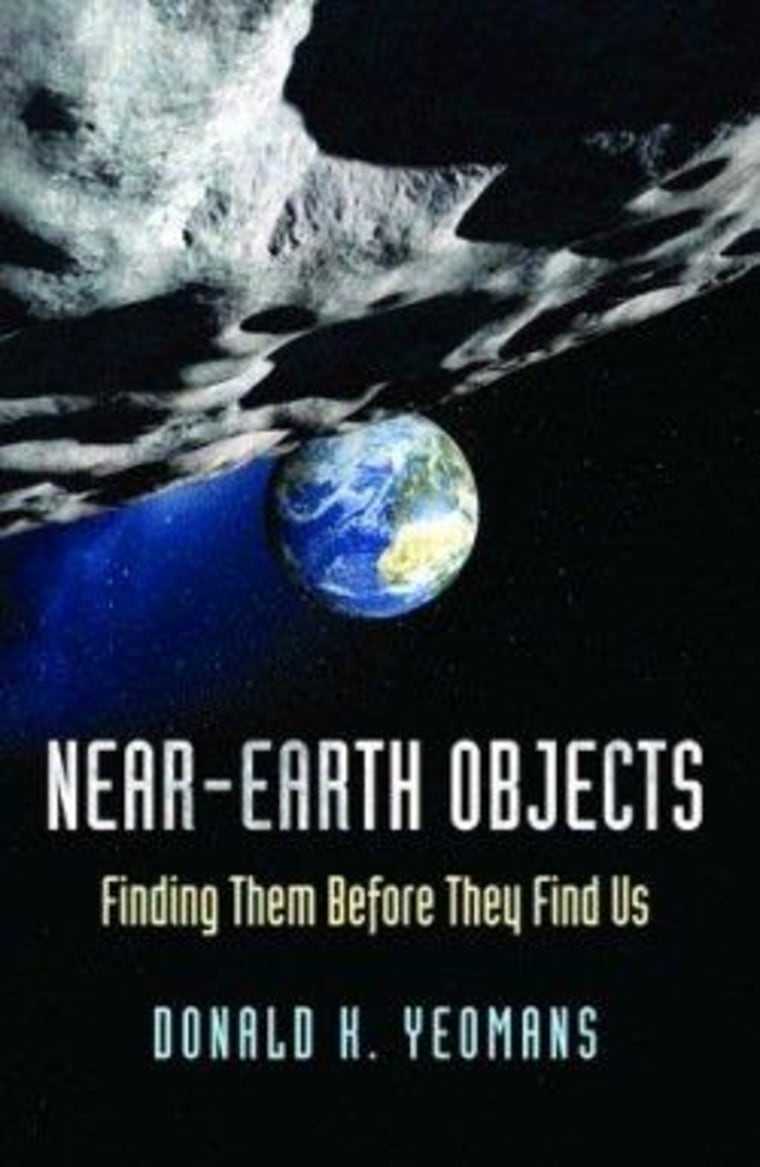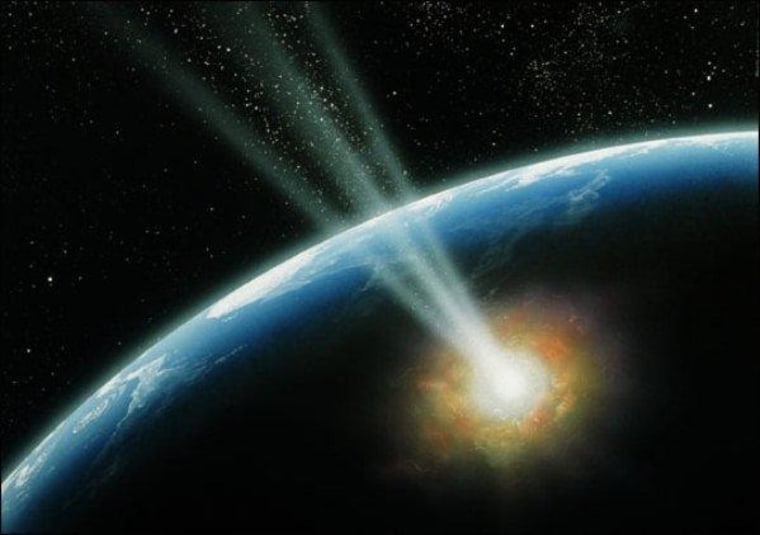NASA's top expert on near-Earth objects says that new telescope systems, including a "last alert" system that's just now being set up, are gradually getting a handle on potentially threatening asteroids. But comets? That's a completely different story.
"We can do something about asteroids. Comets are a problem," said Donald Yeomans, the head of the Near-Earth Object Program at NASA's Jet Propulsion Laboratory in Pasadena, Calif.
Yeomans is the author of "Near-Earth Objects: Finding Them Before They Find Us," a new book sizing up the cosmic perils posed by asteroids and comets — and looking ahead to the potential they offer for scientific discovery and economic exploitation.
For an example of the perils, you need look no further than the dinosaurs — or, more accurately, the lack thereof. Scientists believe an asteroid impact along the coast of Mexico's Yucatan Peninsula set off a chain of events that killed off the dinosaurs and many other species 65 million years ago. A much smaller impact in 1908 blew down half a million acres' worth of trees in Siberia, and could have leveled a city nearly the size of Tokyo if its trajectory were different.


More recently, astronomers have sounded a series of alerts over close encounters with passing asteroids — including three cases involving the asteroids 2012 DA14, 2011 AG5 and Apophis. It turns out that none of those space rocks will hit us in the foreseeable future, but 2012 DA14 is due to come within 13,000 miles on Feb. 15. That's closer than the orbits for geosynchronous satellites. And experts agree it's only a matter of time before astronomers find a large asteroid that's actually on a collision course.
This is why Congress asked NASA in 1998 to identify 90 percent of the asteroids wider than a kilometer (0.6 miles). In 2011, NASA researchers declared that they achieved that goal. But they still have a long way to go to identify the smaller threats: The experts estimate that there are more than a million near-Earth asteroids capable of causing damage on the scale of 1908's Siberian fireball.
Several projects are in the works to catalog those smaller asteroid threats, including some projects that are funded by NASA's observation program for near-Earth objects, which is allocated more than $20 million annually. One such program — known as the Asteroid Terrestrial-impact Last Alert System, or ATLAS — started receiving NASA funding just this month. The $5 million, five-year effort calls for building telescopes in Hawaii that could provide advance warning for the kinds of asteroids that have eluded bigger detection programs.
"We think it's possible to provide a useful degree of warning for most impacts, meaning a day for a 30-kiloton 'town killer,' a week for a 5-megaton 'city killer,' three weeks for a 100-megaton 'county killer,'" the ATLAS team says on its website. (The numbers refer to the same TNT equivalents used to describe nuclear explosions.)
Yeomans acknowledged that even three weeks wouldn't be enough to divert an asteroid from its path — but it would provide enough time to plot the object's course, determine the impact zone and plan for evacuations if necessary.
What about the comets?
And then there are those pesky comets. We're not talking about comets that follow a regular route through the solar system, such as Halley's Comet. The course of those comets can be predicted decades in advance, and so far they appear to pose no threat. Yeomans and other experts are more concerned about long-period comets, which spend most of their time on the solar system's icy edge.
"Long-period comets, defined here as active comets with orbital periods greater than 200 years, are the most difficult objects to mitigate should one be found on an Earth-threatening trajectory," Yeomans says in his book. "The arrival of these objects from the outer solar system cannot be predicted, and the impact warning time would be measured in a few months, not years."
Generally speaking, long-period comets don't become discoverable until they come within the orbit of Jupiter, which would leave about nine months before they hit (or miss) Earth, Yeomans said.
If a truly monstrous comet were on a collision course, the scenario might well play out the way it did in the 1998 disaster movie "Deep Impact." There wouldn't even be enough time to mount a comet-blasting mission like the one that Robert Duvall took on in the movie. Fortunately, Earth's comet impact rate is thought to be less than 1 percent of the asteroid impact rate, Yeomans said. That's one reason why asteroids have dominated the discussion of potential cosmic threats.
From peril to profit?
All this may sound scary — and yes, it's scary enough that experts around the world have been discussing policy initiatives under the aegis of the U.N. Office for Outer Space Affairs. Yeomans is due to attend U.N.-sponsored meetings on space policy in Vienna next month, at just about the time that 2012 DA14 will be flying past. But Yeomans says there's no need to press the panic button.
"No one should be losing sleep over this issue," Yeomans told NBC News this week during his visit to Town Hall Seattle. "We've got much bigger problems, such as global warming or firearm safety. But none of those issues have the capability to bring us back to Square Zero. ... This is sort of an insurance program. You want to know what's out there, and if there's something threatening out there. Twenty years ago, maybe we should have been losing sleep, but we didn't know it."
Twenty years from now, will near-Earth asteroids still be perceived as potential killers — or will they instead be seen as opportunities to make a killing? Some boosters say asteroid mining could eventually generate a trillion dollars' worth of economic activity annually. Two sets of entrepreneurs are working on ventures aimed at laying claim to asteroids that could provide water, oxygen, construction materials and fuel for space-based operations, as well as precious metals that could be brought back to Earth. One venture, Planetary Resources, started up less than a year ago. The other, Deep Space Industries, was unveiled just this week.
Yeomans thinks it's great that investors are willing to put their money into space technologies, but he doubts they'll see a profit anytime soon.
"I don't understand their business model," he said. "What if you were to ask Colonial Americans to invest in the airline industry? Sure, the airline industry is coming, and it's great, but would you invest the Colonial equivalent of your 401(k) in it?"
In his book, Yeomans says the biggest reason to invest in the asteroid search now is to make sure we survive long enough to reap the longer-term payoffs:
"Near-Earth objects may one day be the fueling stations and watering holes for interplanetary exploration," he writes. "Ironically, the easiest ones to reach and mine are also those that are most likely to one day collide with Earth and perhaps disrupt or destroy our fragile civilization. We need to find them early and track them to ensure than none among them has our name on it. While these objects are critically important to our future, if we don't find them before they find us, we may not even have a future."
Update for 11 p.m. ET: I mused in a Twitter tweet whether it'd be better to face a killer asteroid or a killer comet. If you're musing over the same question, here's an extra bit of data from Yeomans' book: A comet streaking in from the outer solar system would typically have three times the impact velocity of a similarly sized Earth asteroid hitting Earth. When you factor in the density difference, "the comet's impact energy would be about twice that of the asteroid," Yeomans says. Considering that we're likely to have more advance warning about an asteroid, I'd probably go with the asteroid if I had to make a choice. Which would you pick?
More about asteroids:
- Reality check for asteroid miners
- Asteroid activists raise funds for space telescope
- Can paintballs save us from asteroid threats?
Alan Boyle is NBCNews.com's science editor. Connect with the Cosmic Log community by "liking" the log's Facebook page, following @b0yle on Twitter and adding the Cosmic Log page to your Google+ presence. To keep up with Cosmic Log as well as NBCNews.com's other stories about science and space, sign up for the Tech & Science newsletter, delivered to your email in-box every weekday. You can also check out "The Case for Pluto," my book about the controversial dwarf planet and the search for new worlds.
